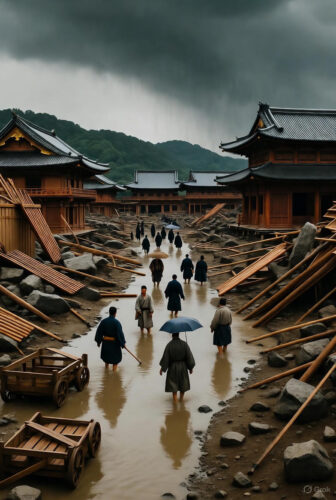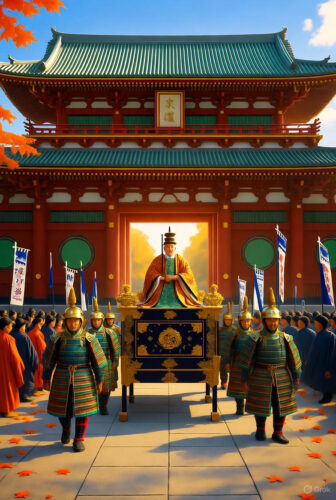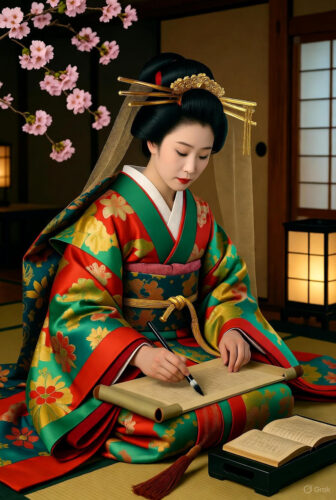Imagine a world where emperors wielded power not just over lands and armies, but over the very fate of culture and innovation. On October 22, 794, in the misty valleys of ancient Japan, one such ruler made a decision that would ripple through centuries, birthing an era of poetic splendor, artistic mastery, and political intrigue. This wasn’t just a relocation of bricks and palaces; it was a daring escape from the shadows of the past, a fresh canvas for a nation’s soul. We’re diving into the story of Emperor Kanmu and the founding of Heian-kyō, the “Capital of Peace and Tranquility” – what we now know as Kyoto. Buckle up for a historical adventure that’s equal parts epic saga and clever life hack, because this ancient move holds keys to unlocking your own potential today.
Let’s set the scene in the turbulent Nara period, the backdrop to Kanmu’s bold gamble. Japan in the 8th century was a land in flux, heavily inspired by the grandeur of Tang China. The capital at Heijō-kyō (modern Nara) had been established in 710, modeled after the Chinese city of Chang’an with its grid streets, massive temples, and bureaucratic systems. But Nara wasn’t all harmony and enlightenment. The Buddhist clergy had grown too powerful, meddling in court affairs like uninvited guests at a royal banquet. Remember Dōkyō, the monk who nearly snatched the throne in the 760s? He charmed Empress Shōtoku so thoroughly that she tried to name him her successor – a scandal that shook the imperial family to its core. Emperors came and went rapidly, with six ruling in just 70 years, each building lavish temples that drained the treasury and empowered the priests further. By the time Kanmu’s father, Emperor Kōnin, ascended in 770 at the ripe age of 62, the court was rife with corruption, factional fights, and a sense that the old ways were suffocating progress.
Enter Prince Yamabe, born in 736, who would become Emperor Kanmu. His early life was no fairy tale. As the son of Kōnin and a consort from the Yamato clan with Korean Baekje roots, Kanmu grew up in a web of palace politics. His mother’s lineage traced back to ancient Korean kings, a fact Kanmu later emphasized to bolster his legitimacy, even issuing edicts treating certain clans as “imperial relatives.” Ascending the throne in 781 at age 45, Kanmu was no passive ruler. He was vigorous, reform-minded, and determined to revive the imperial house’s authority. His reign name, initially Ten’ō and later Enryaku, reflected ambitions for longevity and prosperity. Kanmu fathered 32 children with 16 consorts, securing his lineage – three sons would become emperors themselves. But his real legacy? Tackling the Buddhist stranglehold and expanding Japan’s frontiers.
Kanmu’s first major act was military: campaigns against the Emishi, the indigenous people of northern Honshū, seen as “barbarians” by the Yamato court. In 789, a massive defeat at the Battle of Sufuse humbled the imperial forces, but Kanmu bounced back. He appointed Sakanoue no Tamuramaro as the first Seii Taishōgun in 797, a title that foreshadowed the shoguns of later eras. By 801, Tamuramaro had subdued key Emishi territories, extending imperial control eastward. These wars weren’t just conquests; they were economic boons, bringing new lands and resources under taxation. Kanmu reformed the military too, abolishing universal conscription in 792 and relying on provincial elites, a shift that inadvertently sowed seeds for the samurai class.
But the heart of Kanmu’s reforms was the capital relocation – a double move that reads like a historical thriller. In 784, just three years into his reign, Kanmu uprooted the court from Nara to Nagaoka-kyō, about 30 miles north. Why? To flee the Nara monks’ influence, of course. The new site was chosen for its strategic rivers and defensible terrain, but disaster struck like a curse from the old gods. Floods ravaged the half-built city, famines hit in 789, and the architect Fujiwara no Tanetsugu was assassinated in 785 amid political rivalries. Kanmu’s brother, Prince Sawara, implicated in plots, was exiled and died suspiciously. Omens piled up: comets, earthquakes, and epidemics. The people whispered of vengeful spirits. After a decade of turmoil, Kanmu called it quits on Nagaoka in 793, ordering scouts to find a better spot.
That spot was a basin surrounded by mountains, with the Kamo and Katsura rivers providing natural defenses and trade routes. Construction began furiously in 793, blending Chinese feng shui with Japanese practicality. On October 22, 794 – Enryaku 13, by the old calendar – Kanmu led a grand procession into the new capital, Heian-kyō. Picture it: thousands of courtiers, guards, and laborers in silk robes and armor, banners fluttering under autumn skies. The emperor entered through the Rashōmon Gate, a massive structure symbolizing the city’s southern boundary. Heian-kyō spanned about 2.8 by 3.2 miles, larger than Nara, with a grid of nine north-south avenues and eight east-west streets. The imperial palace, Daidairi, occupied the north, a vast complex of halls like the Chōdō-in for ceremonies and the Buraku-in for banquets. Markets buzzed in the east and west wards, while aristocratic villas dotted the landscape.
Building Heian-kyō was no small feat. Workers – conscripted peasants and artisans – toiled with wood, tile, and earth, erecting structures inspired by Tang architecture but adapted to Japan’s earthquakes and humidity. The palace’s vermilion pillars and green-tiled roofs gleamed, while gardens with ponds and bridges evoked harmony with nature. Kanmu banned new Buddhist temples inside the city limits initially, though two were allowed on the outskirts: Tō-ji and Sai-ji, guardians at the southern gates. This move curbed clerical power, allowing the court to breathe. Yet challenges persisted: the relocations cost a fortune, straining resources and causing unrest. Kanmu purged rivals, exiling or demoting those tied to Nara factions.
With the capital secure, the Heian period (794-1185) unfolded as Japan’s classical zenith. Politically, it started strong under Kanmu but devolved into aristocratic rule. After Kanmu’s death in 806, his sons Heizei, Saga, and Junna navigated succession dramas. Power shifted to the Fujiwara clan, masters of marriage politics. Fujiwara no Yoshifusa became the first sesshō (regent) in 858, and his adopted son Mototsune the first kampaku. By the 10th century, Fujiwara no Michinaga ruled as a shadow emperor, his daughters birthing heirs. The Ritsuryō system – Tang-inspired laws on land, taxes, and bureaucracy – eroded as shōen estates proliferated. These private manors, tax-exempt and immune to officials, enriched nobles and temples, weakening the center. Crime rose; bandits roamed; provinces grew autonomous.
Yet amid decay, culture bloomed like cherry blossoms in spring. Freed from heavy Chinese mimicry after the last Tang embassy in 838, Japan forged kokufu bunka – national culture. Kana scripts emerged: hiragana for flowing prose, katakana for annotations. Women, barred from Chinese studies, excelled in vernacular literature. Murasaki Shikibu’s “The Tale of Genji” (c. 1008), the world’s first novel, painted court romances with psychological depth. Sei Shōnagon’s “The Pillow Book” (c. 1000) sparkled with witty lists and observations. Poets like Ono no Komachi and Ariwara no Narihira crafted waka verses on love and nature, influencing everything from tea ceremonies to modern haiku.
Art shifted to yamato-e, vibrant scrolls depicting seasonal scenes and court life. Beauty ideals were elaborate: women in jūnihitoe (12-layered robes) with colors evoking flowers, blackened teeth, and long hair. Men sported eboshi hats and faint mustaches. Religion evolved too. Kanmu sponsored Saichō and Kūkai’s China trips; Saichō founded Tendai on Mount Hiei, emphasizing universal enlightenment via the Lotus Sutra. Kūkai’s Shingon brought esoteric rituals, mandalas, and mantras, blending Buddhism with Shinto.
The economy hummed on rice and barter, no coins minted after the 10th century. Shōen expanded, creating a feudal undercurrent. Rebellions like Taira no Masakado’s in 939 hinted at warrior rise. The insei system – cloistered emperors ruling post-abdication – curbed Fujiwara briefly under Go-Sanjō (r. 1068-1073). But military clans ascended: Minamoto and Taira. Wars in the north, like the Former Nine Years’ War (1051-1062), honed samurai skills.
The Hōgen (1156) and Heiji (1159) disturbances shattered Fujiwara dominance, elevating Taira no Kiyomori. He installed his grandson as emperor, rebuilt trade with Song China, and crushed rivals, even burning temples. But overreach sparked the Genpei War (1180-1185), a epic clash immortalized in “The Tale of the Heike.” Minamoto no Yoritomo triumphed, establishing the Kamakura shogunate in 1192, ending Heian court rule.
Heian-kyō’s legacy? It endured as capital until 1868, birthing Kyoto’s temples, festivals, and geisha districts. Culturally, it defined Japanese elegance: from Noh theater roots to seasonal aesthetics. Politically, it transitioned Japan to feudalism, with shoguns and samurai echoing Kanmu’s frontier spirit.
Now, fast-forward to today. Kanmu’s shift wasn’t just geography; it was reinvention. By ditching Nara’s toxic influences, he sparked creativity and stability. You can too! Here’s how this historical pivot benefits your life:
– **Break Free from Draining Influences:** Like Kanmu fleeing Buddhist meddling, identify toxic habits or people sapping your energy. Audit your daily routine – that endless social media scroll? Cut it like a bad regent.
– **Embrace Strategic Change for Growth:** The move to Heian fostered cultural blooms. Relocate your “capital” – switch jobs, move cities, or revamp your workspace – to unlock new ideas.
– **Plan for Long-Term Stability:** Kanmu’s grid city symbolized order. Organize your life with systems: meal prep, budgeting apps, or a vision board mirroring Heian’s harmonious layout.
– **Cultivate Personal Culture:** Heian birthed poetry and art. Dedicate time to hobbies – journaling like Murasaki or painting – to enrich your inner world.
– **Build Resilience Against Setbacks:** Nagaoka’s failures didn’t stop Kanmu. View obstacles as omens to pivot, turning job losses into career upgrades.
A 30-Day Renewal Plan Inspired by Kanmu:
– **Days 1-7: Assess and Detach –** Journal what “Nara” elements hold you back. Eliminate one daily, like unsubscribing from negative newsletters.
– **Days 8-14: Scout New Ground –** Research changes: visit potential new gyms, browse online courses, or test a new hobby.
– **Days 15-21: Construct Your Foundation –** Implement basics: set up a dedicated workspace, start a routine with meditation mimicking Shingon rituals.
– **Days 22-28: Populate with Positivity –** Invite supportive people, like court nobles; join communities or mentorships.
– **Days 29-30: Celebrate and Sustain –** Reflect on progress, host a small “procession” like a self-reward dinner, and commit to quarterly reviews.
This plan turns history into action, making you the emperor of your destiny. Fun fact: Heian’s peace lasted centuries – yours can too!

